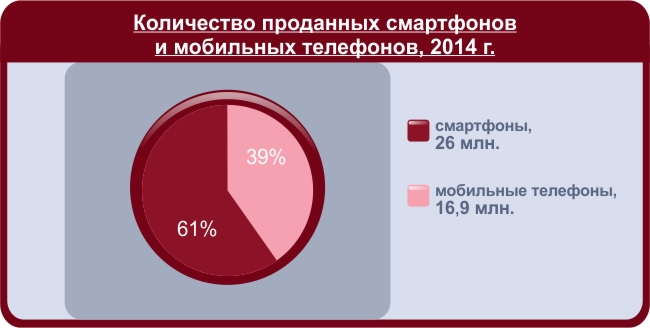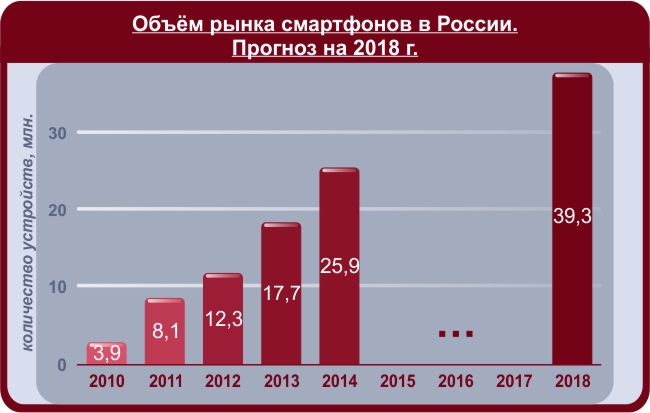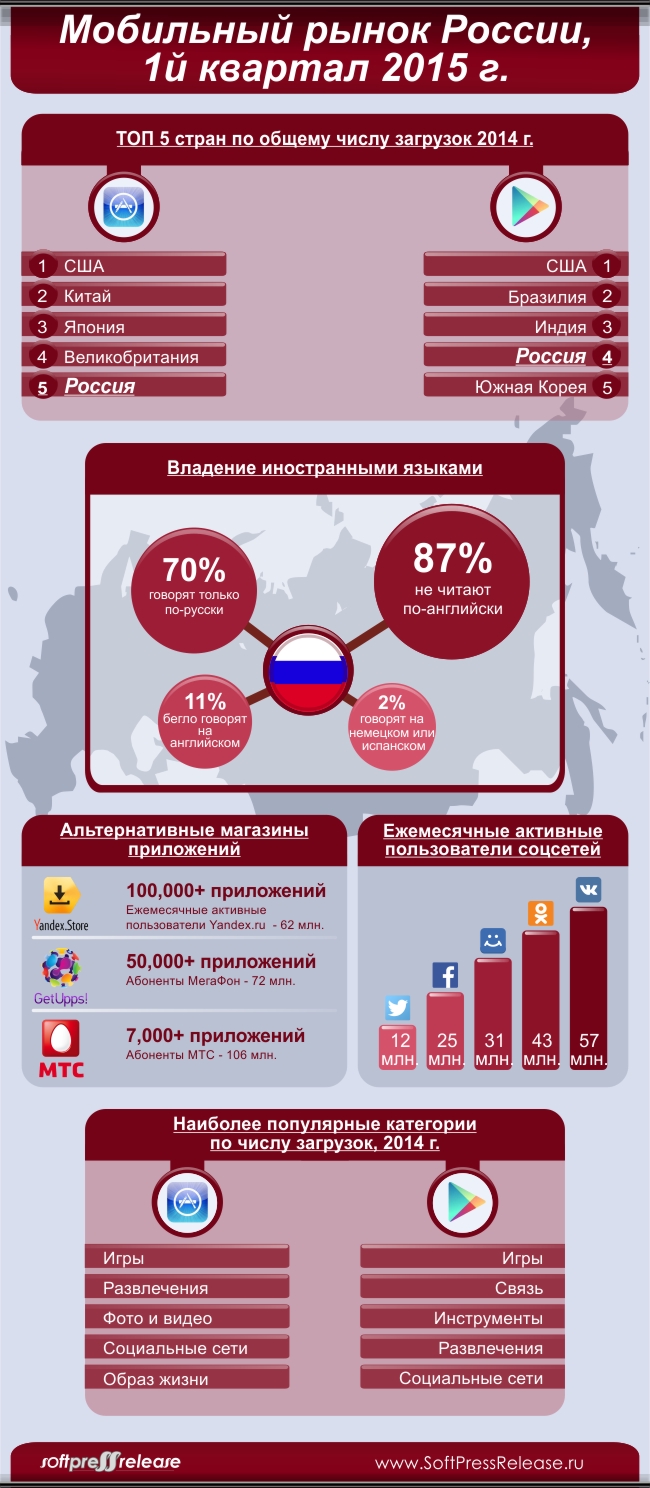Recently, the SoftPressRelease PR agency published an excellent report on the state of affairs on the Russian mobile application market on the Gamasutra pages, which also affected the mobile games market. The company has prepared a version of the material in Russian for us.
The mobile app market is relatively young, but it has grown significantly over the past few years. Its active development worldwide was facilitated by the rapid growth of the mobile device market and the penetration of mobile technologies into all spheres of private and public life. Today, mobile applications are one of the most attractive market segments for investment.
Although the Russian mobile market is significantly smaller than the US, Asian and European markets, many experts share the opinion that it has significant growth potential. According to a study by J’son & Partners Consulting, in 2013 the volume of the Russian mobile application market was estimated at $246 million, and analysts expect that it will continue to grow. The study shows that more than 50% of tablet and smartphone users go online at least once a day and launch video applications and play mobile games every day. It is also reported that 40% of mobile Internet users would rather lose their TV than their smartphone.
According to the App Annie report, Russia ranks fifth in the total number of downloads on iOS, second only to the USA, China, Japan and the UK. The same report shows that in terms of Android downloads, Russia is in fourth place after the USA, India and Brazil. However, a closer look at the revenue from iOS and Android apps makes it obvious that Russia is still far from reaching its full potential, as it ranks 10th and 9th, respectively.
Forecast of the Russian mobile market
Despite the recent downturn in the Russian economy, forecasts regarding its mobile market are quite optimistic. According to the forecasts of J’son & Partners Consulting, in 2015 the Russian mobile application market will grow by 186% on average, and its volume will reach $1.3 billion by 2016. The growth will be provided by such factors as the growing number of mobile devices, the rapid development of 4G networks and the general shift of consumer and communication habits towards mobility (for example, mobile shopping, the development of mobile banking and mobile payment systems, the spread of mobile social networks and mobile messengers, the growing popularity of geolocation services, etc.)
The spread of mobile Internet
At the moment, Russia’s mobile ecosystem is undergoing major changes as a result of the recently introduced principle of technological neutrality. In short: this allowed more players to enter the mobile telecommunications market, which was previously monopolized by the Big Three operators. As a result of growing competition, the quality of services is improving, and prices are gradually decreasing. Moreover, mobile operators are now legally required to provide coverage in localities with a population of 1,000 or more people in order to obtain and maintain their licenses. According to a recent study by eMarketer, the level of mobile communication distribution, which was 80% in 2014, will grow by 6% by 2017, and the number of mobile Internet users in Russia will increase from 61.5 million in 2014 to 88.1 million in 2017.
Mobile Device Sales
2014 was marked by a sharp increase in smartphone sales: 26 million devices were sold in Russia – 47% more than in 2013 (information published by J’son & Partners Consulting). Smartphones accounted for 61% of the total number (43 million) of mobile phones sold. However, it is worth noting that the overall growth of the market is registered due to the increasing sales of budget smartphones (worth $ 50-$110), while other segments of the mobile market are on the decline.
In monetary terms, the Russian smartphone market increased by 20%, and its volume amounted to 216 billion rubles ($ 3.3 million). The main growth factors include an increase in the popularity of mobile Internet and a decrease in the average cost of a smartphone by 19% to $130 in 2014. According to J‘son & Partners Consulting estimates, by 2018 the total volume of the Russian smartphone market will reach 39.9 million devices.
In the tablet market in Russia in 2014, 9 million devices were sold for a total of $1.2 million (according to estimates by mobile retailer Svyaznoy, based on market data from GfK). And although the number of devices sold has increased by a third compared to 2013, the market has not grown in monetary terms, as demand has shifted to more affordable tablet models (up to $80).
Mobile operating systems
If we consider operating systems, Android dominates the Russian mobile market, holding 50.65% of the market as of December 2014. iOS is in second place with 43.59% (15.74% more than in 2013), while Windows Phone is losing ground with a market share of 2.42% (compared to 3.34% in 2013). The total share of all other operating systems is 3.34% (data from The Statistics Portal, December 2014).
Mobile Games market in Russia
Report on the marketing research conducted Mail.Ru Group and Newzoo, claims that the number of mobile players in Russia in 2013 was 33.8 million, 79% of the total number of gamers. However, only 28% of them paid for their gaming experience. According to the data from this report, the growth rate of the Russian mobile games market is amazing: its volume amounted to $55 million in 2011, $99 million in 2012 and $165 million in 2013. And according to J‘son & Partners Consulting forecasts, by the end of 2016, the volume of the Russian mobile market will reach $707 million. Such rapid growth is due to the growing popularity of smartphones and tablets, a decrease in their average cost and an increase in 3G and 4G coverage.
Russian mobile gamers who prefer Android spent approximately 40.8 minutes a day on their gaming sessions in January 2014, which is 4.6 minutes above average, according to a Flurry report called Gaming: The Language of Franco Mobile. According to the report, Russia ranks third, and Germany and the United States are second and first with 47.1 minutes and 51.8 minutes, respectively. The most popular gaming categories among Russian Android users, according to this report, are Casual (56% of all Android gaming sessions) and Arcade&Action (29% of all Android gaming sessions). Taking into account that the percentage of Android users involved in at least one game session from the Casual and Arcade&Action categories is 69% and 64%, respectively, these categories can be identified as the most promising for entering the Russian market.
Monetization in the Russian market
According to the Distimo report published in February 2014, the most common business model in the Russian mobile application market is freemium. The applications distributed through it generate 76% of the total revenue, while the profit share of paid applications without in-game purchases is 20%, and paid applications with in-game purchases are content with a modest 4%. The average revenue per download (ARPD) in Russia is $1.30 (App Store, Overall Top, January 2012 – January 2014), which puts Russia in 9th place in the ARPD world ranking.
Recommendations for entering the Russian mobile market
1. Popular and promising application categories
Most of the mobile applications and services currently available on the Russian market are concentrated in the following segments: social networks, geolocation, games, music, news, content projects and transport services. At the same time, there is a shortage of municipal and tourist mobile services, there is a “stagnation” in the segment of full-fledged online retail and shopping. (information from Componentixstudio)
2. Localization
Entry into the Russian market almost always implies localization. Most Russians do not install or immediately delete a generally useful, but not localized application simply because they do not want to wade through its obscure interface. A sociological study conducted by the Yuri Levada Analytical Center in 2014 in 45 regions of Russia revealed that 70% of Russians do not speak any foreign languages. 11% of Russians are fluent in English, while only 2% know German or Spanish. A study by the international analytical company Common Sense Advisory conducted in 2014 in a number of countries for which English is not the state language (including Russia) showed that 87% of consumers who do not know English do not buy goods and do not use the services of English-language websites.
3. Local partners
Local business partners can provide invaluable assistance. Their experience in the local market, as well as deep knowledge of the language and culture will help prevent marketing mistakes. In addition, they will be responsible for solving administrative issues that are too complicated for an uninformed foreigner.
4. Promotion in local social networks
Reviews and press releases published by popular Russian-language technology blogs and websites usually result in a rapid increase in downloads, but they cannot become a source of stable constant traffic. This is not a bad tactic for the initial launch of the application, but subsequently it is necessary to stimulate the interest of the audience through social networks. Local social networks offer good opportunities to promote applications through advertising in news feeds, user groups and open forums. Interesting content (funny videos, demotivators, useful tips) that can go viral and give a great response, for the best effect should be in Russian. The most popular social networks in Russia are: VKontakte has an audience of 57 million users per month, Odnoklassniki – 43 million, and My World – 31 million. The international social networks Facebook and Twitter have 25 and 12 million users in Russia, respectively.
5. Alternative App stores in Russia
Russian Android smartphone users can download apps from both Google Play and a number of alternative app stores. The appearance and promotion in such stores increases the chances of the application being noticed due to a significantly smaller number of applications compared to Google Play.
The largest Russian alternative store for Android applications is Yandex.Store. Its advantages include a Russian-language interface, support for mobile payments, comprehensive antivirus protection for its more than 100,000 applications and integration with the Yandex payment system.Money. Yandex.Store is preinstalled on devices from Oppo, Explay, teXet, Lenovo, Huawei and a series of Nokia X smartphones. Mobile operator MegaFon has opened its own GetUpps app store! based on Yandex.Store, with special offers for MegaFon subscribers.
Also worth noting is another Russian app store – MTS App Market from the operator MTS Russia. This store uses a subscription model with a monthly payment: all users get unlimited access to 3000+ premium apps and popular games for Android, BlackBerry, Windows Mobile, Bada and Symbian.
5 points to pay attention to before entering the Russian market:
– The Russian mobile market is relatively young, with many underdeveloped segments. At the same time, it shows stable growth dynamics, which is supported by the rapid spread of the mobile Internet. Thus, there are many opportunities for a developer to occupy a profitable niche.
– More than two thirds of mobile devices in Russia run on Android, the popularity of which is steadily growing. The prospects for iOS in Russia are rather doubtful, in particular due to Apple’s decision to increase the cost of the iPhone in rubles by 70% in December 2014. Windows Phone could not take a significant market share.
– To be successful in the Russian market, the application must be adapted and localized, since the overwhelming majority of Russians ignore English-language applications. Russian business partners can provide invaluable assistance in localization and building a marketing strategy.
– Russian social networks provide such opportunities for powerful promotion as advertising in news feeds, viral content in public and user groups, as well as “share” buttons inside applications. Publishing reviews on local websites can give a jump in popularity, but in addition to this, an ongoing advertising campaign is necessary.
– There is less competition in alternative Android app stores, and they give the app a better chance of being noticed.







